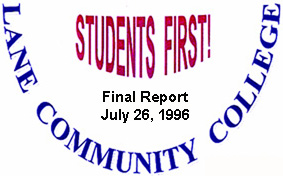|
 CHAPTER THREE: MAJOR FINDINGS
CHAPTER THREE: MAJOR FINDINGS
Table of Contents | Main Students First! Page
This chapter describes the major findings from the main data collection techniques employed by the Students First! Process Redesign Team. As described in Chapter Two, these main data collection techniques include:
- site visits and guest speakers from other community colleges and local businesses to learn about best practices in student services in particular, and customer service, in general
- surveys of Lane students conducted by the Oregon Survey Research Laboratory (OSRL) and the American College Testing (ACT) Service
- input sessions with employees involved in providing services to students
- process maps developed by the redesign team depicting the departments and tasks involved in delivering information, support services, financial transactions services, and enrollment services to students.
This chapter represents a brief summary of these findings, to serve as a preface for the recommendations that follow in Chapter Four. Further details regarding the findings from each data collection technique are in Appendix D.
Site Visits and Guest Speakers from Other Campuses and Local Businesses
- student services in close proximity to one another enhances their effectiveness and student satisfaction with them
- employees need to be cross-trained so that they can support other functions during peak periods
- different skills are required for employees on the front-lines dealing with students, than for technical employees who work behind the scenes
- technology can be used as an enabler to increase student access to information and services
- flexible hours, modes of service delivery, and processes are necessary to provide customer service to populations with different needs and goals
- training in customer service skills is important for those employees who will be working on the front-lines of services to students
Student Surveys
- about sixty percent of student survey respondents are enrolled in credit classes, about thirty-seven percent are enrolled in non-credit classes. The remaining three percent are enrolled in both credit and non-credit classes
- among student survey respondents, most credit students are aiming for a two-year associate's degree, while most non-credit students are taking courses for personal enrichment
- eighty percent of student survey respondents report that they find solutions always or often the first place they go for a questions or problem at Lane
- three quarters of student survey respondents use ClassLine, and ninety-seven percent of these students find it easy to use
- only half of student survey respondents have a Lane student identification card
- eighty-six percent of student survey respondents report that it is easy for them to obtain books and supplies
- thirty-four students surveyed had comments on how monthly billing statements could be made more helpful
- career services, advising services and job placement services are used by a minority of student survey respondents, yet those that have used them see them as helpful
- sixty-five percent of student survey respondents own a computer, and twenty-nine percent have an electronic mail account
- student survey respondents report high levels of satisfaction with Lane, with ninety-four percent saying that they would recommend Lane to a friend, and sixty-eight reporting that they are very satisfied with their overall experiences with Lane services
- among services for which they were asked about accuracy of information received, student survey respondents reported the lowest relative accuracy of information received about prerequisites for courses
- among services for which they were asked about satisfaction, student survey respondents reported the lowest relative degree of satisfaction with financial aid services, however, the dissatisfaction rate was only thirteen percent
Input Sessions
- physical fragmentation of services to students causes students and employees to be bounced around among various locations in order to meet their needs
- there is inadequate space for effective operations of many services to students
- technology is fragmented across campus, with multiple data bases, uneven access to technology, programs that are difficult to use, and lack of training
- information is not accurate, accessible, and regularly updated, and various information sources provide inconsistent information
- the admissions process is highly fragmented, with over seven different applications and processes for different types of students
- ClassLine is not as helpful and easy to use as it could be
- financial policies regarding extension of credit are unclear
- billing statements are confusing and contain a surplus of information
- advising services are fragmented and inconsistent across campus
- job placement and job assistance services are fragmented across campus
- employees go to extra-ordinary lengths to buffer students from complex processes
- employees at the outreach centers often feel out of touch with main campus employees, policies, and processes
Process Maps
- students receive information about Lane from a wide range of sources that are not linked and often maintain different data bases
- admissions processes vary widely according to the type of student being admitted
- little linkage exists between Financial Aid and College Finance, causing students to deal with multiple service providers, policies, and procedures to attend to their registration related financial transactions
- non-registration related fees are handled by over thirteen campus departments
- academic advising services are provided by over eight different campus departments, with little linkage and coordination among them
- counseling and placement services are provided by at least twelve known different campus departments, with little linkage and coordination among them
- little linkage exists among departments offering career and job placement services
|
 CHAPTER THREE: MAJOR FINDINGS
CHAPTER THREE: MAJOR FINDINGS 